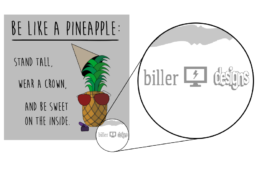Why is this So Difficult?
 It’s a familiar scene. Someone needs just “a short bio” from you and so here you are in front of your blank document trying to figure out where to even start writing this thing. You Google “How to Write a Bio” and try to mash together a bunch of different suggestions and emulate the examples you like, but somehow, this process takes hours. “How can that be?” you think. “This is me! I know plenty about myself! Why can’t I think of anything to write?”
It’s a familiar scene. Someone needs just “a short bio” from you and so here you are in front of your blank document trying to figure out where to even start writing this thing. You Google “How to Write a Bio” and try to mash together a bunch of different suggestions and emulate the examples you like, but somehow, this process takes hours. “How can that be?” you think. “This is me! I know plenty about myself! Why can’t I think of anything to write?”
I’m going to try to help you out. I have written lots of different bios (long, short, and everything in between) for many different things (websites, recital programs, social media) and I find that the best way to approach this task is to have a system, but not so strict a system that it becomes basically a Mad Lib. Cookie cutter bios are everywhere and not only do they all sound the same, they are boring and don’t hold the reader’s attention. If that’s not the whole point, I don’t know what is.
The Process
My process has 3 main parts: Audience + Purpose= Tone, High Points, and Magical Writing Dust.
Audience + Purpose = Tone
First and foremost, you need to know your audience (who will be reading your bio), your purpose (why they will be reading your bio) and once you have solid answers for these two, those answers can inform your tone (the overall feel of your bio). If you are writing content for the About page on your website, your audience is your potential clients or customers, and your purpose is to give them information about your experience and your personality, for lack of a better word. When clients read your bio, they should get a sense of what it will be like to work with you.

Your tone can do this as well as the specific pieces of information you share. Working with a person who has a very serious personality is going to be a very different experience than working with someone who has a more laid-back attitude. Using very neutral, professional language projects seriousness, while using more colloquial language projects levity. Neither is better or worse, but attracting clients who have a work style similar to yours can be beneficial to both you and your clients, so it’s important to be true to your own voice. Identifying your audience and clarifying your purpose will help you decide on the tone of your bio.
High Points
Now that you kind of have an idea how you want your bio to sound, you need to get a plan for what you want to say. The two most important components of your bio are:
Relevant Experience – ex. Industry experience for 5 years, previous job responsibilities, training classes you’ve attended or certifications or degrees you’ve earned.
Personal Tidbits – ex. You have lived in the area your whole life, you like dogs, enjoy long walks on the beach.
To add that special, readable quality to your bio, you need one more element:
Something Extra – ex. Your business philosophy, your commitment to supporting a local charity, why or how you got into this field in the first place. This piece is where you can really let your personality shine!
What I usually do is just list at least 3 or 4 things for every High Point. You might not use every one of them, but it’s good to have lots of material to choose from. Once you’ve gotten your High Points organized, then it’s time to for the Magical Writing Dust.
Magical Writing Dust
This is where you actually write the bio! Yay! I like to think of it as sprinkling Magical Writing Dust on all of your information so it becomes more interesting than just a list of facts about you. This is another place that your Tone from Step 1 comes into play. The structure and language can make your writing sound very professional or very casual, or somewhere in the middle. First, you need to decide how you want your bio to lay out. A classic structure is Intro, Experience (in chronological order), and Conclusion. Since you’ve already figured out what pieces of information you want to include, it’s just a matter of choosing what section they go into. For example, the High Points in my bio are organized like this:
Intro:
Twitter bio
Interests
Experience (in chronological order):
Early Design
Website Creation
Tech Start-Up
Current Business
Closing:
Business Philosophy
I could just as easily move the elements around and still have an informative bio, but I wanted to strike a more informal tone, so I opened with my interests rather than the more prevalent, and arguably more professional, style of closing with interests. What can I say? I’m a rebel.
Connecting the Dots
 When you’ve got everything in the order you want, add in some connecting language. Before, after, next, and then are all good ways to transition from one sentence to another and help your bio tell a story. From a writing standpoint, a best practice is not to start more than two sentences in a row with the same word, so those connectors can come in pretty handy.
When you’ve got everything in the order you want, add in some connecting language. Before, after, next, and then are all good ways to transition from one sentence to another and help your bio tell a story. From a writing standpoint, a best practice is not to start more than two sentences in a row with the same word, so those connectors can come in pretty handy.
Ex. I worked at one place doing something. I worked at another place doing another thing.
Can become
After becoming interested in the field, I worked at a place doing something. Then, when I had advanced my skills, I moved on to another place doing a different thing.
Another good way to vary your language in this step is to flip the sentences a little.
Ex. I worked at a place doing something
Can become
I worked doing something at a place.
Just remember that the way to keep your reader interested is to give them the information they need wrapped up in an engaging package that is true to your voice.
You Did It!

Once you string all of your sufficiently different sentences together, that’s it! You can basically repeat this process any time you need to write an informative summary of yourself and your experience. It’s handy to have the list of potential bio components around so that if you want to emphasize a certain part of your work history or experience, you can easily add it in or swap other less relevant pieces out. Then you can just sprinkle whatever kind of Magical Writing Dust you need on it at the end with your language and structure to determine the tone. Having two separate bios- a more low key bio, as well as a very professional bio- ready to go, is also a great way to save TONS of time writing and rewriting later on.
And to top it off, it is just your lucky day! I have created a worksheet to help walk you through these steps (get it here). Feel free to it pass along to other bio writers out there. Sharing is caring, my friends. Until next time!
-CB <3



